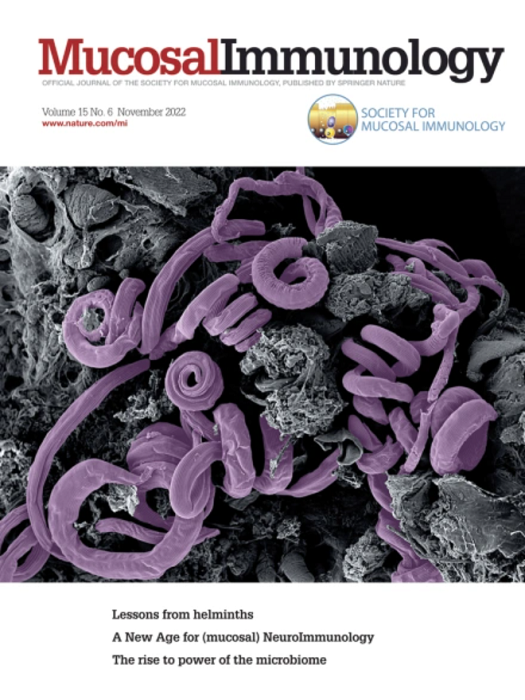Increased ocular plasma cells induce damaging α-synuclein+ microglia in autoimmune uveitis
IF 7.6
2区 医学
Q1 IMMUNOLOGY
引用次数: 0
Abstract
Autoimmune uveitis (AIU) is an immune-inflammatory disease that can lead to blindness. However, incomplete understanding of the involved immune cell subsets and their contributions to retinal injury has hindered the development of effective AIU therapies. Using single-cell RNA sequencing and immunofluorescence, we identified α-synuclein+ microglia as the primary subset of damaged ocular cells in the eyes of the experimental autoimmune uveitis (EAU) mouse model. Ocular-infiltrating plasma cells (PCs) were shown to express multiple inflammatory factors, particularly TNF-α, which promoted the production of α-synuclein+ microglia. Studies of heterogeneous PC subtypes revealed that MUC1- PCs represent the primary pathogenic subset, secreting multiple cytokines. Although MUC1+ PCs expressed TGF-β, they exhibited long-lived characteristics and secreted IgG and IgM, thereby prolonging disease progression. Finally, the small G protein Rab1A, also expressed in the PCs of Vogt-Koyanagi-Harada (VKH) patients, was found to mediate autophagy and NF-κB expression, influencing PCs survival and inflammatory responses. Silencing or knocking down Rab1A in PCs inhibited their survival. This study elucidates potential mechanisms underlying the neuroimmune inflammatory response and highlights the previously unrecognized role of infiltrating PCs in AIU, offering novel therapeutic targets for this disease.
自身免疫性葡萄膜炎患者眼浆细胞增加诱导α-突触核蛋白+小胶质细胞损伤。
自身免疫性葡萄膜炎(AIU)是一种可导致失明的免疫炎症性疾病。然而,对所涉及的免疫细胞亚群及其对视网膜损伤的贡献的不完全了解阻碍了有效的AIU治疗的发展。利用单细胞RNA测序和免疫荧光技术,我们发现α-突触核蛋白+小胶质细胞是实验性自身免疫性葡萄膜炎(EAU)小鼠模型中受损眼细胞的主要亚群。眼浸润浆细胞(PCs)表达多种炎症因子,尤其是TNF-α,促进α-突触核蛋白+小胶质细胞的产生。对异质性PC亚型的研究表明,MUC1- PC是主要致病亚群,分泌多种细胞因子。MUC1+ PCs虽然表达TGF-β,但它们表现出长寿的特点,并分泌IgG和IgM,从而延长了疾病的进展。最后,小G蛋白Rab1A也在Vogt-Koyanagi-Harada (VKH)患者的pc中表达,被发现介导自噬和NF-κB的表达,影响pc的生存和炎症反应。沉默或敲除pc中的Rab1A抑制了它们的存活。本研究阐明了神经免疫炎症反应的潜在机制,并强调了浸润性pc在AIU中以前未被认识到的作用,为这种疾病提供了新的治疗靶点。
本文章由计算机程序翻译,如有差异,请以英文原文为准。
求助全文
约1分钟内获得全文
求助全文
来源期刊

Mucosal Immunology
医学-免疫学
CiteScore
16.60
自引率
3.80%
发文量
100
审稿时长
12 days
期刊介绍:
Mucosal Immunology, the official publication of the Society of Mucosal Immunology (SMI), serves as a forum for both basic and clinical scientists to discuss immunity and inflammation involving mucosal tissues. It covers gastrointestinal, pulmonary, nasopharyngeal, oral, ocular, and genitourinary immunology through original research articles, scholarly reviews, commentaries, editorials, and letters. The journal gives equal consideration to basic, translational, and clinical studies and also serves as a primary communication channel for the SMI governing board and its members, featuring society news, meeting announcements, policy discussions, and job/training opportunities advertisements.
 求助内容:
求助内容: 应助结果提醒方式:
应助结果提醒方式:


